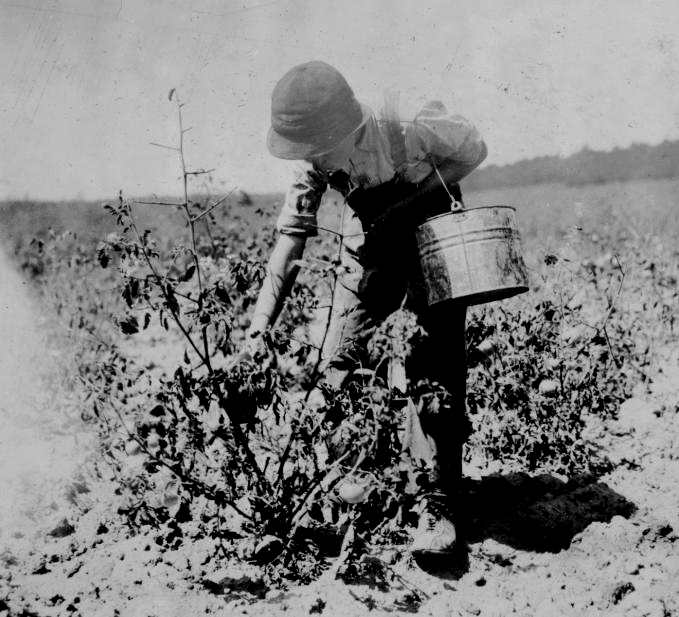
Figure 1.--This 13-year old boy in 1916 is picking tomatoes on the farm of W.T. Hill in Cabool, Missouri. Photographer: Lewis W. Hine. |

|
America's agricultural development took many forms. Colonists in the north founded family fatms. In the South plantation agriculture became important. The frontier provided land for all who wanted it which enable America to develop differently than in England itself. The Second Continental Congress passed the Land Ordinance of 1785. This dividided the land into townships. And each townships were divided into 36 sections. This proivided the foundation of public land policy in the Northwest Territory which was establisged by the Northwest Ordinance (1787). These two laws were arguably the most important pieces of legislation in American history. It created the first American Territory and banned slavery there. The two laws accelerating America's westward expansion and provided the system by which settlers obrained possession of family farm plots at low cost. It meant that the foundation of the new northern states would be the family farm. The Homestead Act (1862) continued the same system west of the Mississipp River. White boys worked on family farms or might get work on on other faems. Abraham Lincoln's father used to hire him out to neigboring farmers and kept the money. This caused ill-feeling between the two which was never resolved. Black boys worked as slaves on plantations from an early age. (Not all slaves worked on plantations and other farms, but the great mnajority did.) After the Civil War, many Black and White families took up share cropping.
Before World War II, agricultural work was a major area in which children worked. For some it was a way of earning pocket money. Others had to work to help support the family.
Colonists in the north founded family fatms. In the South plantation agriculture became important. The frontier provided land for all who wanted it which enable America to develop differently than in England itself. The Second Continental Congress passed the Land Ordinance of 1785. This dividided the land into townships. And each townships were divided into 36 sections. This proivided the foundation of public land policy in the Northwest Territory which was establisged by the Northwest Ordinance (1787). These two laws were arguably the most important pieces of legislation in American history. It created the first American Territory and banned slavery there. The two laws accelerating America's westward expansion and provided the system by which settlers obrained possession of family farm plots at low cost. It meant that the foundation of the new northern states would be the family farm. The Homestead Act (1862) continued the same system west of the Mississipp River. White boys worked on family farms or might get work on on other faems. Abraham Lincoln's father used to hire him out to neigboring farmers and kept the money. This caused ill-feeling between the two which was never resolved.
Virginia and the other southern colonies developed differently than the northern colonies which developed on the basis of the family farm. The plantation based on slave labor became central to the ecomonies of the southern colonies. At independence, many Americans in both the South and North saw slavery as an inefficent dieing system. Most believed that slavery would gradually disappear. The invention of the cotton gin changed all this. Suddently cotton plantations to feed the Britih and other European mills became enormously progitable. Black boys worked as slaves on plantations from an early age. (Not all slaves worked on plantations and other farms, but the great majority did.) Most southerners neither owned slaves or plantations, but the planters were of great economic importance and
canme to dominate the region politically. Small farmners and workers in the South unlike free labor in the north did not see the slave system as a threat even though it tended to supress wage rates and farm prices. Rather most came to views it as necessary to control the slaves.
After the Civil War, many Black and White families took up share cropping. Sharecropping is an agricultural system which developed in the Southern states during the Civil War. It was a farm tenancy system in which families worked a farm or section of land in return for a share of the crop rather than wages. Sharecropping replaced the plantation system destroyed by the Civil War. The victorious Federal authorities which occupied the South did not seize plantations, but empancipation meant that the owners no longer had a captive laor force. The former planters, even those activly engged in rebellion, for the most part still had their land, but no slaves or money to pay wages. The former slaves on the other hand did not have jobs or land and because they had been denied education, had few options. Sharecropping developed because the former slaves and planters needed each other. The principal crop continued to be cotton. And the planters under the sharecropping system contnued to a large degree to control the lives of the blacks working their land. While the system at first developed to obtain black labor, eventually poor whites also entered the sharecropping system. The system varied, but in many cases all the cropper brouht to the arrangement was his labor. The planter provided the land, but also commonly animals, equipment, seeds and other items. The land owners also commonly advanced credits for the family's living expences until the crop was harvested. After World War II, migrtion to the North, farm mechinization, education, other employment options, and the Civil Rights movement brought the system to an end.
Navigate the Boys' Historical Clothing Web Site:
[Return to the Main U.S. working boys agriculture page]
[Return to the Main U.S. working boys area page]
[Return to the Main U.S. working boys area page]
[Return to the Main U.S. activities page]
[Introduction]
[Activities]
[Biographies]
[Chronology]
[Clothing styles]
[Countries]
[Bibliographies]
[Contributions]
[Essays]
[FAQs]
[Glossaries]
[Images]
[Links]
[Registration]
[Tools]
[Boys' Clothing Home]
